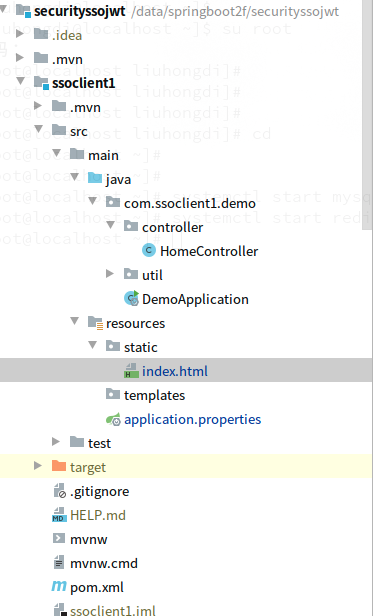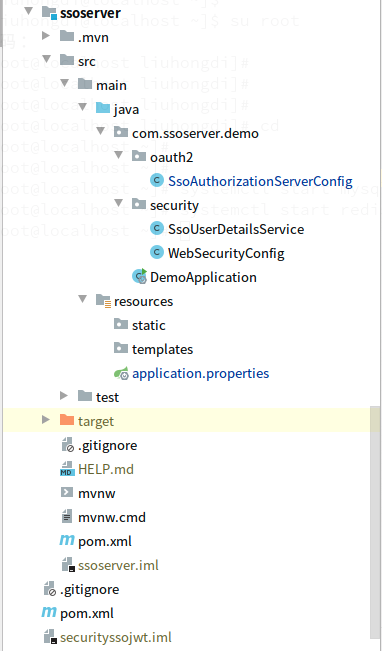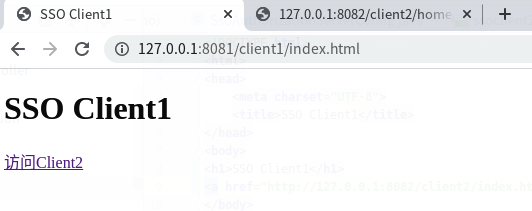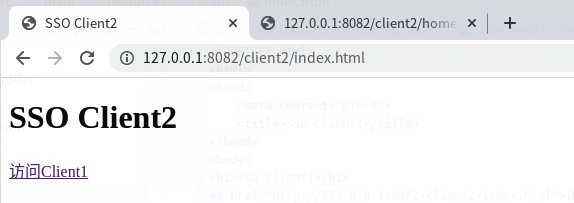spring boot:spring security+oauth2+sso+jwt实现单点登录(spring boot 2.3.3)
一,sso的用途 ?
1,如果有多个应用系统,用户只需要登录一次就可以访问所有相互信任的应用系统。
不需要每次输入用户名称和用户密码,
也不需要创建并记忆多套用户名称和用户密码。
2,系统管理员只需维护一套统一的用户账号,方便、简单。
而不必管理很多套的用户账号。
3, 如果需要开发新的应用系统,可以直接使用单点登录平台的用户认证服务,简化开发流程。
4,oauth和sso的区别:
oauth2解决的是服务提供方(微信等)给第三方应用授权的问题,
sso解决的是大型系统中各个子系统如何共享登陆状态的问题
说明:刘宏缔的架构森林是一个专注架构的博客,
网站:https://blog.imgtouch.com
本文: https://blog.imgtouch.com/index.php/2023/05/25/springbootspringsecurityoauth2ssojwt-shi-xian-dan-dian-deng-lu-springboot233/
对应的源码可以访问这里获取: https://github.com/liuhongdi/
说明:作者:刘宏缔 邮箱: 371125307@qq.com
二,演示项目的相关信息
1,项目地址:
https://github.com/liuhongdi/securityssojwt
2,功能说明:
演示了基于oauth2实现sso
3,项目结构:如图:



三,配置文件说明
1,ssoserver的 pom.xml
<dependency> <groupId>org.springframework.boot</groupId> <artifactId>spring-boot-starter-web</artifactId> </dependency> <!--security--> <dependency> <groupId>org.springframework.boot</groupId> <artifactId>spring-boot-starter-security</artifactId> </dependency> <!--oauth2--> <dependency> <groupId>org.springframework.security.oauth</groupId> <artifactId>spring-security-oauth2</artifactId> <version>2.5.0.RELEASE</version> </dependency> <!--jwt--> <dependency> <groupId>org.springframework.security</groupId> <artifactId>spring-security-jwt</artifactId> <version>1.1.1.RELEASE</version> </dependency> <!--jaxb--> <dependency> <groupId>javax.xml.bind</groupId> <artifactId>jaxb-api</artifactId> <version>2.3.0</version> </dependency> <dependency> <groupId>com.sun.xml.bind</groupId> <artifactId>jaxb-impl</artifactId> <version>2.3.0</version> </dependency> <dependency> <groupId>com.sun.xml.bind</groupId> <artifactId>jaxb-core</artifactId> <version>2.3.0</version> </dependency> <dependency> <groupId>javax.activation</groupId> <artifactId>activation</artifactId> <version>1.1.1</version> </dependency>
2,ssoclient1的 pom.xml
<dependency> <groupId>org.springframework.boot</groupId> <artifactId>spring-boot-starter-web</artifactId> </dependency> <!--security--> <dependency> <groupId>org.springframework.boot</groupId> <artifactId>spring-boot-starter-security</artifactId> </dependency> <!--oauth2--> <dependency><groupId>org.springframework.security.oauth</groupId> <artifactId>spring-security-oauth2</artifactId> <version>2.5.0.RELEASE</version> </dependency> <!--jwt--> <dependency> <groupId>org.springframework.security</groupId> <artifactId>spring-security-jwt</artifactId> <version>1.1.1.RELEASE</version> </dependency> <!--oauth2 autoconfigure--> <dependency> <groupId>org.springframework.security.oauth.boot</groupId> <artifactId>spring-security-oauth2-autoconfigure</artifactId> <version>2.3.3.RELEASE</version> </dependency>
3,ssoclient2的 pom.xml
<dependency> <groupId>org.springframework.boot</groupId> <artifactId>spring-boot-starter-web</artifactId> </dependency> <!--security--> <dependency> <groupId>org.springframework.boot</groupId> <artifactId>spring-boot-starter-security</artifactId> </dependency> <!--oauth2--> <dependency><groupId>org.springframework.security.oauth</groupId> <artifactId>spring-security-oauth2</artifactId> <version>2.5.0.RELEASE</version> </dependency> <!--jwt--> <dependency> <groupId>org.springframework.security</groupId> <artifactId>spring-security-jwt</artifactId> <version>1.1.1.RELEASE</version> </dependency> <!--oauth2 autoconfigure--> <dependency> <groupId>org.springframework.security.oauth.boot</groupId> <artifactId>spring-security-oauth2-autoconfigure</artifactId> <version>2.3.3.RELEASE</version> </dependency>
4,ssoserver的application.properties
server.port = 8080 server.servlet.context-path = /server spring.security.user.password=123456 #error server.error.include-stacktrace=always #log logging.level.org.springframework.web=trace logging.level.org.springframework.security=debug
5,ssoclient1的application.properties
security.oauth2.client.client-id=client1 security.oauth2.client.client-secret=client1secrect #需要认证时候跳转的地址 security.oauth2.client.user-authorization-uri=http://127.0.0.1:8080/server/oauth/authorize #请求令牌地址 security.oauth2.client.access-token-uri=http://127.0.0.1:8080/server/oauth/token #解析 security.oauth2.resource.jwt.key-uri=http://127.0.0.1:8080/server/oauth/token_key #security.oauth2.resource.jwt.key-value=imooc #sso server.port=8081 server.servlet.context-path=/client1
6,ssoclient2的application.properties
security.oauth2.client.client-id=client2 security.oauth2.client.client-secret=client2secrect #需要认证时候跳转的地址 security.oauth2.client.user-authorization-uri=http://127.0.0.1:8080/server/oauth/authorize #请求令牌地址 security.oauth2.client.access-token-uri=http://127.0.0.1:8080/server/oauth/token #解析 security.oauth2.resource.jwt.key-uri=http://127.0.0.1:8080/server/oauth/token_key #sso server.port=8082 server.servlet.context-path=/client2
四,java代码说明:
1,ssoserver的WebSecurityConfig.java
@Configuration public class WebSecurityConfig extends WebSecurityConfigurerAdapter { @Resource private SsoUserDetailsService ssoUserDetailsService; @Bean public PasswordEncoder passwordEncoder() { return new BCryptPasswordEncoder(); } @Override protected void configure(AuthenticationManagerBuilder auth) throws Exception { auth.userDetailsService(ssoUserDetailsService).passwordEncoder(passwordEncoder()); } @Override protected void configure(HttpSecurity http) throws Exception { http.formLogin().and().authorizeRequests().anyRequest().authenticated(); } }
2,ssoserver的SsoUserDetailsService.java:
@Component public class SsoUserDetailsService implements UserDetailsService { @Autowired private PasswordEncoder passwordEncoder; //本来应该从数据库加载数据,此处供仅演示 @Override public UserDetails loadUserByUsername(String username) throws UsernameNotFoundException { System.out.println("----------------------loadUserByUsername"); if (username.equals("laoliu") == false) { throw new UsernameNotFoundException("用户名不存在"); } return new User(username, passwordEncoder.encode("123456"), AuthorityUtils.commaSeparatedStringToAuthorityList("ROLE_USER")); } }
3,ssoserver的SsoAuthorizationServerConfig.java:
@Configuration @EnableAuthorizationServer public class SsoAuthorizationServerConfig extends AuthorizationServerConfigurerAdapter { //配置供访问的客户端的账户 @Override public void configure(ClientDetailsServiceConfigurer clients) throws Exception { clients.inMemory() // 注册一个客户端,设置名称 .withClient("client1") // 设置客户端阴匙 .secret(new BCryptPasswordEncoder().encode("client1secrect")) // 对应客户端登录请求URI .redirectUris("http://127.0.0.1:8081/client1/login") // 授权方式 .authorizedGrantTypes("authorization_code", "password", "refresh_token") // 授权范围 .scopes("all") // 是否自动同意,如果采用非自动同意,则需要用户手动授权 .autoApprove(true) .and(). withClient("client2") .redirectUris("http://127.0.0.1:8082/client2/login") .secret(new BCryptPasswordEncoder().encode("client2secrect")) .authorizedGrantTypes("authorization_code", "password", "refresh_token") .scopes("all") .autoApprove(true); } @Override public void configure(AuthorizationServerEndpointsConfigurer endpoints) throws Exception { endpoints.tokenStore(jwtTokenStore()).accessTokenConverter(jwtAccessTokenConverter()); } @Override public void configure(AuthorizationServerSecurityConfigurer security) throws Exception { security.tokenKeyAccess("isAuthenticated()"); } @Bean public TokenStore jwtTokenStore() { return new JwtTokenStore(jwtAccessTokenConverter()); } @Bean public JwtAccessTokenConverter jwtAccessTokenConverter(){ JwtAccessTokenConverter converter = new JwtAccessTokenConverter(); //指定signkey converter.setSigningKey("liuhongdi"); return converter; } }
4,ssoclient1的HomeController.java
@Controller @RequestMapping("/home") public class HomeController { //查看登录后的用户信息 @RequestMapping("/session") @ResponseBody public String getsession(){ //session String userone = SessionUtil.getCurrentUserName(); System.out.println("user:"+userone); if (userone == null) { return "not login"; } else { return userone; } } }
5,ssoclient1的SessionUtil.java
public class SessionUtil { //得到security所保存的用户 public static String getCurrentUserName(){ Authentication authentication = SecurityContextHolder.getContext().getAuthentication(); if (authentication.isAuthenticated() && !(authentication instanceof AnonymousAuthenticationToken)) { Object principal = authentication.getPrincipal(); //System.out.println(principal); if (principal instanceof String) { return (String)principal; } else if (principal instanceof UserDetails) { String currentuser = ((UserDetails) principal).getUsername(); return currentuser; } else { //System.out.println("not instanceof UserDetails"); } return null; } return null; } }
6,其他非关键代码可访问github查看
五,测试效果
1,按以下顺序启动三个模块:
ssoserver
ssoclient1
ssoclient2
2,先访问client1,
http://127.0.0.1:8081/client1/home/session
会跳转到:
http://127.0.0.1:8080/server/login
如图:

我们输入用户名 laoliu,密码 123456
这个是写死在代码中的演示账号
登录后会跳转到:

这个url会打印当前登录用户的用户名
我们新打开一个标签页:
http://127.0.0.1:8082/client2/home/session
我们之前并未从client2登录,查看效果:

可以看到也已经登录
3,通过html页面跳转访问:
http://127.0.0.1:8081/client1/index.html
返回:

点击 访问client2 的链接

可正常访问
六,查看spring boot版本
. ____ _ __ _ _ /\\ / ___'_ __ _ _(_)_ __ __ _ \ \ \ \ ( ( )\___ | '_ | '_| | '_ \/ _` | \ \ \ \ \\/ ___)| |_)| | | | | || (_| | ) ) ) ) ' |____| .__|_| |_|_| |_\__, | / / / / =========|_|==============|___/=/_/_/_/ :: Spring Boot :: (v2.3.3.RELEASE)





【推荐】国内首个AI IDE,深度理解中文开发场景,立即下载体验Trae
【推荐】编程新体验,更懂你的AI,立即体验豆包MarsCode编程助手
【推荐】抖音旗下AI助手豆包,你的智能百科全书,全免费不限次数
【推荐】轻量又高性能的 SSH 工具 IShell:AI 加持,快人一步
· 开发者必知的日志记录最佳实践
· SQL Server 2025 AI相关能力初探
· Linux系列:如何用 C#调用 C方法造成内存泄露
· AI与.NET技术实操系列(二):开始使用ML.NET
· 记一次.NET内存居高不下排查解决与启示
· 阿里最新开源QwQ-32B,效果媲美deepseek-r1满血版,部署成本又又又降低了!
· 开源Multi-agent AI智能体框架aevatar.ai,欢迎大家贡献代码
· Manus重磅发布:全球首款通用AI代理技术深度解析与实战指南
· 被坑几百块钱后,我竟然真的恢复了删除的微信聊天记录!
· 没有Manus邀请码?试试免邀请码的MGX或者开源的OpenManus吧